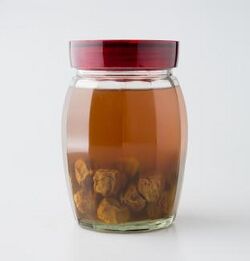Biology:Maesil-ju
 | |
| Type | Plum wine |
|---|---|
| Country of origin | Korea |
| Alcohol by volume | 10-35% |
| Ingredients | Maesil (plums) |
| Korean name | |
| Hangul | 매실주 |
|---|---|
| Hanja | 梅實酒 |
| Revised Romanization | maesil-ju |
| McCune–Reischauer | maesil-chu |
| IPA | [mɛ.ɕil.t͈ɕu] |
Maesil-ju (매실주; 梅實酒), also called plum wine, plum liquor, or plum liqueur, is an alcoholic drink infused with maesil (plums).The exact origins of Maesil-ju are unknown, but it is thought to date back to the Goryeo Dynasty (918-1392)[1].[2][3][4][5]
Ingredients
Maesil-ju is made with maesil (매실; 梅實; "plums"), preferably ripe hwangmae (황매; 黃梅; "yellow plums"), which are yellowish in color, fragrant and firm.[6][7][8] Unripe cheongmae (청매; 靑梅; "green plums")—firmer and less fragrant—can also be used.[8][9] Bruised or over-ripened plums may make the wine cloudy.[8] Damaged fruits should be avoided, as direct contact of plum seeds with alcohol may produce a small amount of prussic acid, due to the amygdalin in plum seeds.[10] However, toxicity vanishes after a year of maturation.[10] Ripe plums have much lower amygdalin content.[citation needed]
Typically, 3 litres (0.66 imp gal; 0.79 US gal) of soju (of 20% ABV) and 100–150 grams (3.5–5.3 oz) of sugar is used per 1 kilogram (2.2 lb) of plums.[8] Sugar can be substituted with slightly more honey, and soju of 20% ABV can be substituted by 2 litres (0.44 imp gal; 0.53 US gal) soju (or any other unflavored spirit) of 30% ABV and 1 litre (0.22 imp gal; 0.26 US gal) of water.[8]
Preparation
Plums are washed in cold water and dried on a tray for a day.[8] Dried plums and soju are added to a sterilized glass or earthenware jug and infused for about 100 days.[8] The fruits are then removed by sieving, and sugar is added to the plum wine.[8] The wine can be consumed immediately, but three to six months of maturation will greatly enrich the wine's flavour.[8]
Commerce
Popular maesil-ju products include Mae hwa soo,[11] Matchsoon,[12] and Seoljungmae.[13]
See also
- Maesil-cha, plum tea
- Maesil-cheong, plum syrup
- Umeshu, Japanese plum liqueur
- Suanmeitang, Chinese plum beverage
References
- ↑ "What Is Maeshil-ju" (in en). https://travellingsouthkorea.com/what-is-maeshilju/.
- ↑ "maesil-ju". National Institute of Korean Language. http://stdweb2.korean.go.kr/search/View.jsp?idx=113322.
- ↑ Nguyen, Stacy (22 December 2010). "10 Asian food makeovers for your holiday party". http://nwasianweekly.com/2010/12/10-asian-food-makeovers-for-your-holiday-party/.
- ↑ Joshi, V. K.; Panesar, P. S.; Rana, V. S.; Kaur, S. (2017). "Science and Technology of Fruit Wines: An Overview". in Kosseva, Maria R. (in English). Science and Technology of Fruit Wine Production. London: Academic Press. pp. 49. ISBN 9780128008508. https://books.google.com/books?id=nWOdBgAAQBAJ&pg=PA49.
- ↑ Shaw, Lucy (20 November 2012). "db Eats: Bibigo". https://www.thedrinksbusiness.com/2012/11/db-eats-bibigo/.
- ↑ "maesil". National Institute of Korean Language. http://stdweb2.korean.go.kr/search/View.jsp?idx=112622.
- ↑ "hwangmae". National Institute of Korean Language. http://stdweb2.korean.go.kr/search/View.jsp?idx=380600.
- ↑ 8.0 8.1 8.2 8.3 8.4 8.5 8.6 8.7 8.8 손, 수정 (20 May 2013). "새콤달콤 향긋한 '매실청·매실주' 제대로 알고 담그세요" (in ko). The Farmers Newspaper. ISSN 1227-5778. http://www.nongmin.com/article/ar_detail.htm?ar_id=217321.
- ↑ "cheongmae". National Institute of Korean Language. http://stdweb2.korean.go.kr/search/View.jsp?idx=329225.
- ↑ 10.0 10.1 권, 대익 (21 June 2016). "청매실 독성 논란, 진실은?" (in ko). Hankook Ilbo. http://www.hankookilbo.com/v/3baa02efff6b4731bcbcf6702599226d.
- ↑ "MAE HWA SOO". http://www.jinrousa.com/products.[yes|permanent dead link|dead link}}]
- ↑ "Matchsoon". http://bohae.co.kr/en/product/product.html?num=3.
- ↑ "Seoljungmae". http://www.lotte.co.kr/eng/02_bussiness/food4.jsp.
 |


